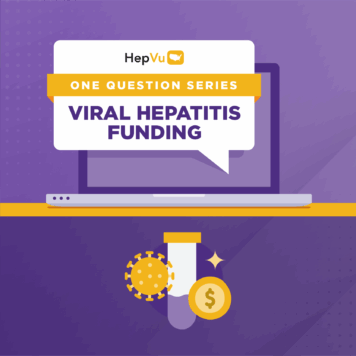Dr. Monica Graybeal, PharmD, is a Hepatitis C ambulatory and community pharmacist at Yakima Valley Farm Workers Clinic and an adjunct professor at Washington State University.
Q: You’ve been working to diagnose, treat, and care for Hepatitis C patients at the Yakima Valley Farm Workers Clinic in Spokane, Washington, for more than a decade. How did you first become involved in Hepatitis C care and how has the field changed in recent years?
My involvement with Hepatitis C truly started in late 2015. This was about two years after the release of Hepatitis C cure medications. At that time, many patients were in long referral queues to see gastroenterology or infectious disease specialists in order to get access to medication, with some patients even waiting for nearly nine months.
Historically, we know that at federally qualified health centers (FQHC), such as the Yakima Valley Farm Workers Clinic, the patient populations living with Hepatitis C have low linkage to care rates. For us, we wanted to know how could we as pharmacists and non-specialists treat these patients and increase their linkage to care. This eventually led us to develop a program that allowed the pharmacist to become the provider and utilize drug therapies. What once began as a small program within one clinic has now grown into a telehealth program across four of our major sites in Washington. Many states now allow pharmacists to prescribe under collaborative drug therapy agreements. This type of agreement is becoming more common throughout the United States.
In the beginning, we faced many more barriers to access than we do today, including needing a specialist, requirements for drug rehabilitation pre-treatment, and minimum fibrosis requirements. These obstacles were quite prominent, and we were fortunate to be working in a state as progressive as Washington because our Medicaid system paved the way to eliminate these barriers and treat all patients. While we still face some barriers today with both private and public insurance, we now have systems of care in place that remove certain barriers.
Q: You were previously recognized for your efforts to improve access to Hepatitis C treatment for local patients in Washington. What barriers to access have you observed for these at-risk communities?
At-risk communities face multiple barriers to treatment. First and foremost, there’s an associated stigma around viral hepatitis, and because of this, patients may not disclose their status to health care providers for fear of how they may be treated. Many of my patients have been denied treatment in the past for psychosocial factors or their perceived lifestyle choices, and they thought this would always apply to them. Provider and public education are needed to decrease the stigma and encourage more testing and treatment.
The second barrier is the availability of treatments for at-risk communities. There are many patients living with Hepatitis C who reside in areas with little access to or knowledge of health care programs. We need to encourage the adoption of syringe exchange programs and treatment within substance use disorder treatment facilities, and primary care facilities. We cannot expect to be successful in eliminating Hepatitis C while continuing to treat it as a specialty condition.
Q: In recent years, the largest increase in new Hepatitis C infections has been among people under 40 and is likely linked to the opioid epidemic. How has Washington responded to this trend and how do you see the trend evolving?
From 2010 to 2015, Washington saw a 350 percent increase in newly reported acute Hepatitis C cases. It’s imperative to stop new infections of viral hepatitis but, without increasing linkage to care, we cannot expect different results.
In September 2018, Washington Governor Jay Inslee issued a directive to the state’s executive and small cabinet agencies to address Hepatitis C. This directive featured two parts:
- Increase access to cures for patients through contracted purchasing of medication
- Form a committee to draft a Hepatitis Elimination Strategy
The Elimination Strategy includes a very specific focus on the populations deeply impacted by the opioid epidemic or injection drug use and recommends expanding access to syringe service programs, harm reduction services, and medication treatment for opioid use disorders – particularly in areas that have limited access. I will say that I appreciate Washington and Governor Inslee for their willingness to address this program head-on; it’s a progressive model that I hope can affect change not only in our state but across the U.S. It’s been a blessing and opportunity to be involved in this program and I really appreciate that.
Q: In July 2019, Washington launched the Hep C Free Washington Plan to Eliminate Hepatitis C in Washington State by 2030. As a member of the initiative’s coordination committee – and knowing that the Western U.S. has the highest rates of Hepatitis C infections in the country – what are the most immediate and significant steps the state is taking to reach this goal?
In essence, the coordination committee’s strategy boils down to three steps: access to treatment, harm reduction, and education.
The most immediate step the state took was to increase access to medication – which includes making patients aware of their treatment options and simplifying the overall prescribing process. In addition, the coordination committee is working on harm reduction and education. Our goal is to increase the amount of treating providers that we have and make sure they are in places where our at-risk patients are already being seen.
Q: You have partnered with Project ECHO to help streamline the prior authorization process for Hepatitis C medications. How does the ECHO model help you address the needs of your patients and provide better outcomes for vulnerable populations?
Project ECHO is an amazing program that helped me build my competency as a provider, as well as circumnavigate barriers that are placed in front of primary care providers. The ECHO model is not traditional telemedicine, where the specialist assumes care of the patient, but is instead tele-mentoring. This is more of a guided practice model where the participating clinician retains responsibility for managing the patient.
As some insurance providers require specialist consults before approving medication to treat patients, Project ECHO serves as an opportunity to help patients see the specialist they need without having to physically visit a specialty office. Without this invaluable service, I know that many of my patients would never have been able to access treatment. One example that struck me is a patient of mine who was referred several times to specialist care for treatment but never went. When I asked him why he did not go, he said, “Four miles might as well be four million.”
I’ve been part of Project ECHO since 2016 and, in addition to increased access, it also provides comradery, support, and up-to-the-minute education. I cannot sing the praises of Project ECHO enough. The competency and the overall teamwork that this program enables is revolutionary and it’s very infectious to have that sort of drive in a room.




